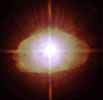| . |  |
. |
 Champaign - September 13, 1999 - The discovery of a new type of low-surface-brightness reflection nebula around aging stars has provided important clues about how stars lose mass and form planetary nebulae.
Champaign - September 13, 1999 - The discovery of a new type of low-surface-brightness reflection nebula around aging stars has provided important clues about how stars lose mass and form planetary nebulae."The results from a recently completed optical imaging survey of proto-planetary nebula candidates has shown us that stars don't lose mass in a spherically symmetric way at the ends of their lives," said Margaret Meixner, a professor of astronomy at the University of Illinois. "Some other process of mass loss -- such as an axisymmetric superwind -- is occurring." As certain types of stars age, their stellar winds create glowing envelopes of gas and dust called planetary nebulae. Intermediate-mass stars -- like the sun -- move through a transitional proto-planetary nebula stage on their way to becoming planetary nebulae. "One of the most significant changes that occurs during the transition is the emergence of axisymmetry in the circumstellar shell of gas and dust," Meixner said. "While most stars show a high degree of spherical symmetry, most planetary nebulae display either bipolar or elliptical symmetry. Therefore, the departure from spherical symmetry must take place somewhere along the evolutionary sequence between the two phases." To investigate potential morphological trends during the transition, Meixner and colleagues Toshiya Ueta (a U. of I. graduate student) and Matthew Bobrowsky (a research scientist at Orbital Sciences Corp.) studied 27 candidate proto-planetary nebulae with the Hubble Space Telescope. "The Hubble's high-resolution imaging capabilities allowed us to identify low-surface-brightness reflection nebulosities around 21 of the candidate objects," Meixner said. "All 21 nebulae showed varying degrees of asphericity, and we clearly recognized two basic types of structure." In the first type of structure -- never before observed in proto-planetary nebulae -- a bright, central star is embedded in a faint, elliptically elongated shell of gas and dust. In the second type, the central star is partially or completely obscured by a bipolar structure. "The fact that we see elliptical structures in addition to bipolar structures helps to constrain the time scale of when the shaping process occurred," Meixner said. "The intrinsic axisymmetry of these reflection nebulosities demonstrates that the axisymmetry frequently found in planetary nebulae predates the proto-planetary nebula phase." Meixner and her colleagues suggest that the axisymmetry found in proto-planetary nebulae could be created by an equatorially enhanced stellar superwind. The onset of the superwind would initiate the morphological shift from spherical to axial symmetry, becoming more pronounced in planetary nebula. Meixner presented her team's findings at a special conference on asymmetrical planetary nebulae, held Aug. 3-6 at the Massachusetts Institute of Technology.
Related News Baskets at SpaceDaily
Additional Offsite Links
|
| |||||||||
| The content herein, unless otherwise known to be public domain, are Copyright 1995-2016 - Space Media Network. All websites are published in Australia and are solely subject to Australian law and governed by Fair Use principals for news reporting and research purposes. AFP, UPI and IANS news wire stories are copyright Agence France-Presse, United Press International and Indo-Asia News Service. ESA news reports are copyright European Space Agency. All NASA sourced material is public domain. Additional copyrights may apply in whole or part to other bona fide parties. Advertising does not imply endorsement, agreement or approval of any opinions, statements or information provided by Space Media Network on any Web page published or hosted by Space Media Network. Privacy Statement All images and articles appearing on Space Media Network have been edited or digitally altered in some way. Any requests to remove copyright material will be acted upon in a timely and appropriate manner. Any attempt to extort money from Space Media Network will be ignored and reported to Australian Law Enforcement Agencies as a potential case of financial fraud involving the use of a telephonic carriage device or postal service. |